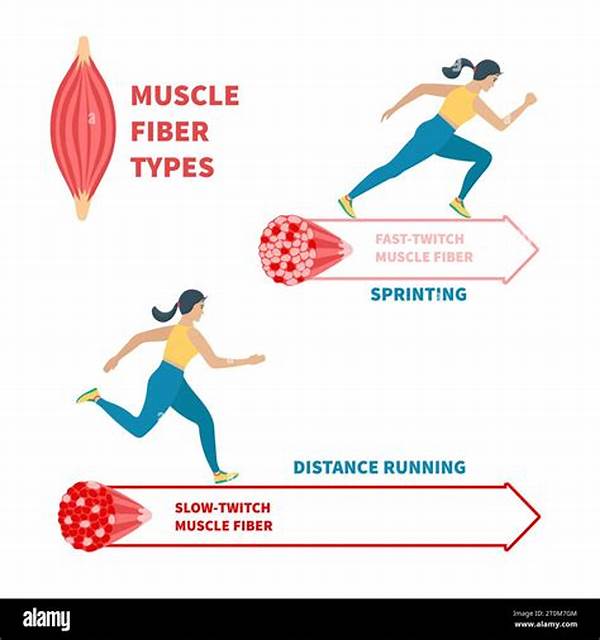Differences Between Fast-twitch And Slow-twitch Muscle Fibers

Muscle fibers are fascinating components of the human anatomy that significantly contribute to our movement, endurance, and strength. Whether you’re sprinting a 100-meter dash or participating in a marathon, different muscle fibers come into play. This fact leads us to the exciting discussion of the differences between fast-twitch and slow-twitch muscle fibers. Imagine your body as a vehicle. Fast-twitch fibers are like the turbo engine, designed for speed and power, while slow-twitch fibers are akin to the engine of a reliable, long-distance car, engineered for endurance and consistency.
Read More : Sports Lifestyle Is A New Trend Among Millennial Youth In 2025
Fast-twitch muscle fibers are responsible for explosive bursts of energy. They are ideal for short, intense activities such as weightlifting, sprinting, or boxing. These fibers generate more force but are quick to fatigue. They have greater ATPase activity, which facilitates rapid energy release, boosting performance in high-intensity activities. However, because they rely heavily on anaerobic metabolism, they are not sustainable for long periods. Consider them the fireworks of the human body—bright, explosive, and fleeting.
In stark contrast, slow-twitch muscle fibers focus on endurance and are crucial for sustained activities like cycling, swimming, or distance running. These fibers are fatigue-resistant and excel at converting oxygen into fuel over long durations, thanks to their reliance on aerobic metabolism. Packed with mitochondria and rich in myoglobin, they are the key players in endurance sports. If fast-twitch fibers are fireworks, slow-twitch fibers are the gentle, reliable campfire that burns steadily throughout the night.
Understanding the differences between fast-twitch and slow-twitch muscle fibers can be a game-changer for athletes and fitness enthusiasts. Tailoring your workout regime according to the fiber type you wish to enhance can optimize performance. For those aiming to improve explosive strength, incorporating high-intensity interval training (HIIT) can be beneficial. Meanwhile, those targeting endurance should focus on low-intensity, prolonged exercise.
The Role of Genetics in Muscle Fiber Composition
One intriguing aspect of muscle fibers is their genetic determination. While training can enhance your muscle fibers’ efficiency and growth, your innate muscle fiber composition is largely genetic. It’s why some people naturally thrive in sprinting events while others excel in marathons. Genetic predisposition plays a critical role, but through targeted training, one can maximize the efficiency of both fast and slow-twitch fibers.
—
Purpose of Understanding Muscle Fibers
Understanding your muscle fibers isn’t just for athletes but for anyone interested in enhancing their physical health and performance. By acknowledging the differences between fast-twitch and slow-twitch muscle fibers, individuals can develop more effective workout strategies tailored to their personal goals, whether that’s boosting their sprint speed or improving their endurance for long-distance running.
Training Implications
An athlete looking to improve in their sport must recognize the need to create a balance between training different muscle fibers. Sprinting and weightlifting benefit from fast-twitch muscle enhancements, which can be achieved through short, intensive workouts. On the other hand, activities such as long-distance running and cycling necessitate the development of slow-twitch fibers through extended, less intense exercise periods.
Balancing Training Goals
Achieving a balanced training routine is paramount for both professional athletes and fitness aficionados. Those whose sports demand explosive power and speed should intensify their focus on fast-twitch fibers, while endurance athletes should dedicate ample time to developing slow-twitch fibers. The intricate balance of these fibers determines your efficiency in any physical activity, allowing you to tailor your workouts for optimized results.
Social media influencers, personal trainers, and gym enthusiasts regularly discuss the differences between fast-twitch and slow-twitch muscle fibers, thanks to their crucial role in defining our physical capabilities. This understanding allows for a revolutionized approach to training, ensuring no one wastes time on ineffective exercise regimes.
The story doesn’t end at just understanding the fibers. Implementing this knowledge into a structured workout plan is pivotal for anyone looking to elevate their fitness journey. Testimonials from athletes who refined their training by acknowledging their muscle fiber types highlight the transformative potential of this insight.
Read More : Physical Training For Sprinting And Table Tennis
Enhancing Performance
Elite athletes often have testimonials about how understanding their muscle fiber composition significantly boosted their performance. For instance, sprinters tend to have a higher percentage of fast-twitch fibers, which provides them with the explosive speed they need. Similarly, marathoners who understand and train their slow-twitch fibers find they can sustain energy and optimize performance over long distances.
Recognizing the differences between fast-twitch and slow-twitch muscle fibers is not just an interesting fact about muscle composition; it is a keystone in personalizing athletic training regimes. Innovations in sports science and muscle biology continue to enrich our insights, empowering athletes and fitness enthusiasts to shape their capabilities effectively.
Summarizing Muscle Fiber Differences
—
Myths and Facts About Muscle Fibers
When it comes to muscle composition, misconceptions abound. One common myth is that you cannot change your muscle fiber type through training. While it’s true that your genetic makeup largely determines your muscle fiber composition, studies show that certain training can indeed optimize the efficiency of both fast-twitch and slow-twitch fibers. Transitioning between fiber types is limited, but adaptability within each type is certainly within reach.
For instance, consistent endurance training can enhance the oxidative capacity of fast-twitch fibers, allowing them to function similarly to slow-twitch fibers over time. Conversely, regular high-intensity training can increase the hypertrophy and power output of slow-twitch fibers, making them act more like their fast-twitch counterparts in periods of high-intensity demand.
Science Behind Muscle Fibers (H3)
Research delves deeper into the nuances of muscle fiber composition by analyzing the interplay of training, diet, and rest. Proteins such as myosin in fast-twitch fibers, compared to those in slow-twitch, explain the variance in speed and endurance capacity. Additionally, studies show recovery times vary significantly between these fiber types post-exercise, with slow-twitch fibers recovering more quickly due to their resilience.
—
Training Tips for Muscle Fibers
Understanding the differences between fast-twitch and slow-twitch muscle fibers and integrating this knowledge into your fitness strategy can have a profound impact on your athletic performance. Not only does it enable you to focus on your strengths, but it also provides clarity on areas that require extra work. Get to know your body better, and let the science of muscle fibers guide you to your peak potential.



